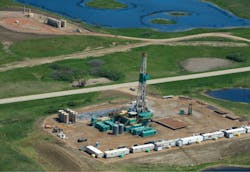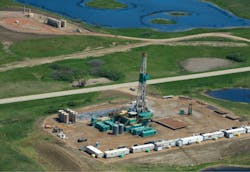Yergin: US energy policies must reflect unconventional resources
US energy policies should be adjusted to reflect a changed energy outlook resulting from growing unconventional oil and gas activity, experts told a US House Energy and Commerce subcommittee's hearing.
The question of the US unconventional revolution's potential geopolitical consequences has triggered international discussions, IHS Vice Chairman Daniel Yergin said in written testimony for the Feb. 5 hearing.
Unconventional resources were discussed earlier this month at the Munich Security Conference, a world forum for leading defense and security officials, Yergin noted.
"This kind of question was never on that agenda before," he said. Expanded oil and gas supplies unquestionably increase US energy security and make the nation less vulnerable to supply interruptions.
"However, there will remain only one global oil market, and a major disruption anywhere would affect the entire market," he said.
Another question is how growing US unconventional production will affect US involvement in the Middle East, Yergin said.
"Current net US imports from the Persian Gulf are equivalent to 8% of total consumption, as it is," he said. "Even if that number goes down, the nature of US interests in the region go well beyond direct oil imports to [its] importance for the global economy and global security."
Production climbs
The US Energy Information Administration estimates crude oil and condensate production averaged 6.4 million b/d in 2012, an 800,000 b/d increase from 2011 that was largely driven by tight oil operations, said Adam Sieminski, the US Department of Energy analysis and forecast division's administrator.
"This increase in US annual oil production is the largest since Col. [Edwin] Drake drilled the first crude oil well in Pennsylvania in 1859," Sieminski said.
EIA forecasts another US crude production increase for 2013 to an average 7.3 million b/d, while the 7.9 million b/d average it expects in 2014 would be the highest domestic production level since 1988.
Ongoing tight oil development will be crucial, Sieminski said.
"Drilling in tight oil plays in the Williston basin's Bakken formation in North Dakota and Montana, the Western Gulf basin's Eagle Ford formation, and the Permian basin in Texas is expected to account for the bulk of forecast production growth over the next 2 years," Sieminski said.
EIA estimates 2012 US gas production averaged 69.2 Bcf/d and anticipates 2013 and 2014 averages will be similar as production from dry plays decline while liquids production grows, he added.
LNG exports likely
Yergin said LNG exports have become the dominant US energy topic, and that they need to be considered in terms of the overall US supply and global competition.
"Owing to the very large resource base, the market in the US is demand-constrained rather than supply-constrained," he told the subcommittee.
"Larger markets—whether they be in electric power, industrial consumption, transportation, or exports—are required to maintain the investment flow into the development of the resources," Yergin said.
While markets and economics will determine how much US LNG eventually is exported, US policymakers should consider wider questions when discussing whether LNG exports should be allowed, Yergin said.
"For decades, the United States has made the free flow of energy supplies one of the cornerstones of foreign policy. It is a principle we have urged on many other nations," he said.
Yergin asked, "How can the United States, on one hand, say to a close ally like Japan—suffering energy shortages [following the Fukushima nuclear power plant accident]—please reduce your oil imports from Iran, and yet turn around and, on the other, say new natural gas exports to Japan are prohibited?"
Policies limit growth
Mary J. Hutzler, a distinguished senior fellow at the Institute for Energy Research (IER), noted large production gains have occurred mainly on state and private land.
Producers increasingly have moved from federally controlled onshore and offshore acreage because it takes more than 300 days to get a drilling permit compared with a month on private and state land, she said.
Areas that the federal government could open to oil and gas development include the Arctic National Wildlife Refuge (with an estimated 10.4 billion bbl of crude and 8.6 tcf of gas), the US Outer Continental Shelf off the Lower 48 states (86 billion bbl of oil and 420 tcf of gas), and geologic provinces north of the Arctic Circle (90 billion bbl of oil and 1,669 tcf of gas), Hutzler said.
The Congressional Budget Office estimated that rents, royalties, and bonuses will generate about $150 billion over 10 years for the federal government under current policies.
Another $7 billion could be realized during the same period if certain off-limit areas were opened to oil and gas leasing, she said.
IER, which considers the CBO estimates conservative, commissioned its own study that found that US gross domestic product could increase $127 billion/year for the next 7 years and $450 billion/year in the long run if addition federal lands and waters were opened to exploration and production, Hutzler said.
"Most impressively, the opening of federal lands would have a cumulative increase in economic activity of up to $14.4 trillion over 30 years," she said.
Jennifer Morgan, the World Resources Institute's Climate and Energy Program director, warned that developing abundant domestic energy resources without regard to climate and other environmental consequences would be a serious mistake.
"The investment choices we make today will shape our energy and economic future for decades to come; thus we must deliberately think longer-term and consider the range of risks and costs that will be compounded if today's investments lock in a pollution-intensive energy future," she said in written testimony.
In assessing US energy resources, policymakers should take into account the impact climate change now has on the domestic energy infrastructure, as well as how avoiding greater future climate impacts can inform energy policy choices, Morgan suggested.
About the Author

Nick Snow
NICK SNOW covered oil and gas in Washington for more than 30 years. He worked in several capacities for The Oil Daily and was founding editor of Petroleum Finance Week before joining OGJ as its Washington correspondent in September 2005 and becoming its full-time Washington editor in October 2007. He retired from OGJ in January 2020.

